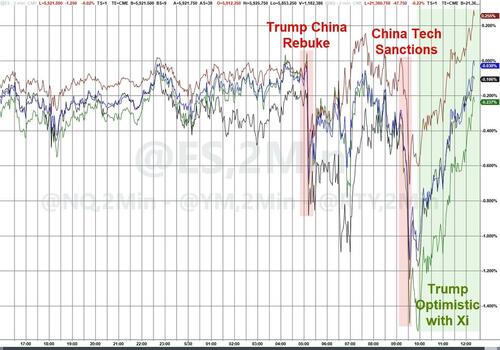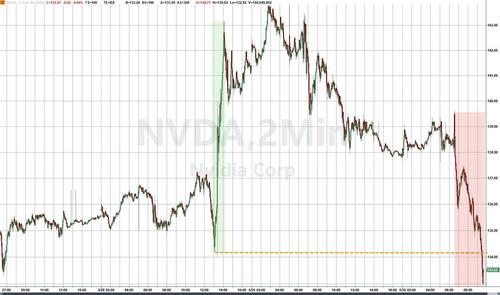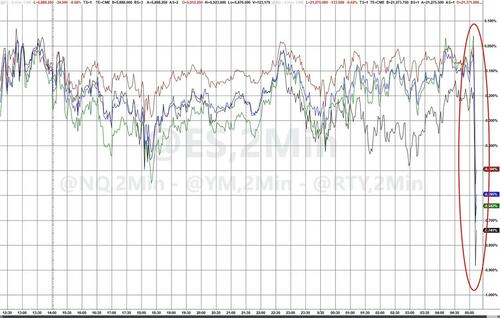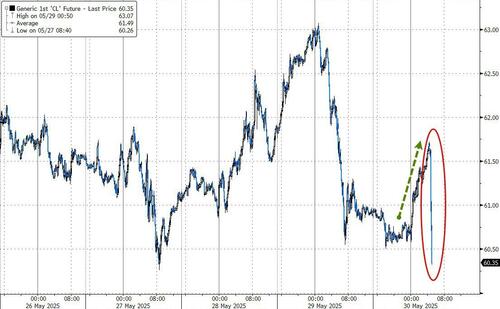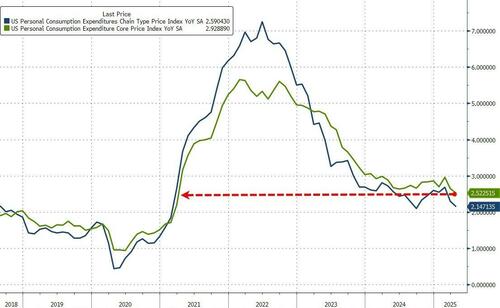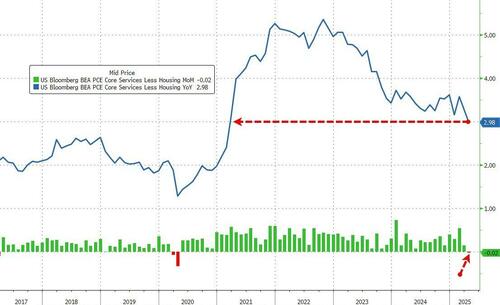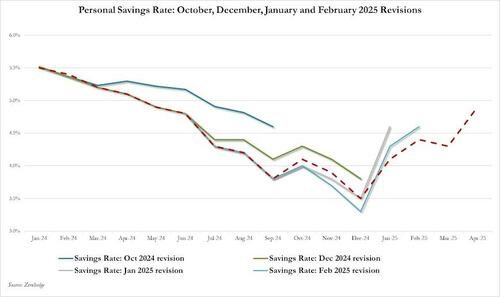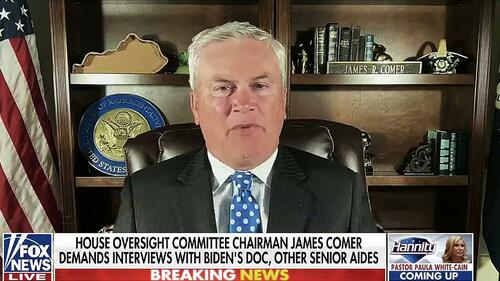“If you believe what you like in the Gospels, and reject what you don’t like, it is not the Gospel you believe, but yourself.”
Distinction Matter - Subscribed Feeds
-
Site: Zero HedgePolice Arrest Suspects In Murder Of Infowars JournalistTyler Durden Fri, 05/30/2025 - 15:05
Authored by Luis Cornelio via HeadlineUSA,
Law enforcement officials have arrested two suspects in connection with the murder of Infowars reporter Jamie White.
 The Infowars set. (ThreeSixty Asset Advisors via AP)
The Infowars set. (ThreeSixty Asset Advisors via AP)
The Austin Police Department announced that 17-year-old Rodney Charles Hill, Eloy Adrian Camarillo, and two unidentified 15-year-olds face murder charges after allegedly killing White outside his Austin, Texas, home. Police arrested Camarillo last month.
BREAKING: All 4 Suspects in @InfoWars Writer Jamie White’s Murder Arrested, per @AdanSalazarWins
— Dan Lyman (@realdanlyman) May 29, 2025
- Eloy Camarillo, 17
- Rodney Charles Hill, 17
- Two 15-year-old suspects
All have been charged with capital murder
RIP Jamie. We all miss you.https://t.co/XcozlA3m5TAccording to court documents, the suspects were attempting to break into White’s Kia on March 9 when he confronted them and was fatally shot. White was rushed to a nearby hospital but was pronounced dead the following morning.
Detectives said White’s vehicle had a broken window and blood inside, presumably from a cut. Austin police said Kia cars have become frequent targets in Austin due to a flawed security system that makes them easier to steal.
Austin Police Detective Jason Jones said the suspects were tracked through a stolen vehicle they drove to White’s residence. Investigators relied on the car’s data, cellphone signal records and license plate reader scans to locate the suspects, according to KVUE.
Jamie White
— Alex Jones (@RealAlexJones) March 11, 2025
1988 - 2025
American Patriot
Remembering Murdered Infowars Journalist, Jamie White.
Rest In Peace pic.twitter.com/jDbZroAptI“We believe this is a very unfortunate and tragic series of senseless events leading to [White’s death], involving the four individuals who obviously have no value for human life,” Jones said, as quoted by the news outlet.
He added that all individuals believed to be involved are in custody, though the investigation remains ongoing.
White was a rising journalist and well-regarded writer for Infowars. His killing stunned conservative circles, particularly Infowars founder Alex Jones, who shared several social media posts honoring White’s legacy.
“Jamie White, such a good friend of mine,” Jones said in a video, while filming White’s desk. “This makes me sick.”
White had previously celebrated his time with Infowars by posting a photo with Jones in 2023, writing, “Nobody is more committed to defeating the New World Order than him.”
Today is a massive victory for free speech.
— Jamie White (@whiteisthefury) December 11, 2023
Been an honor working with @RealAlexJones for the last 7 years. Nobody is more committed to defeating the New World Order than him.
And the best is yet to come!#FreeSpeech #TeamHumanity #AlexJones pic.twitter.com/glAyKCtUSA -
Site: Zero HedgeChaotic Day In US Stocks As Trump & China Trade Headlines Spark Dump'n'PumpTyler Durden Fri, 05/30/2025 - 15:00
Update (1500ET): If ever there was a day which exposed the markets' sensitivity to China trade policy - it was today as an early rebuke by Trump was followed by threats of new sanctions and then an optimistic tone: “I’m sure that I’ll speak to President Xi and hopefully we’ll work that out,”
* * *
Update (1230ET): So much for the TACO trade...
Trump came out swinging early (as we detailed below) and has now followed up with an upper cut as Bloomberg reports, the Trump administration plans to broaden restrictions on China’s tech sector with new regulations to capture subsidiaries of companies under US curbs.
Officials are drafting a rule that would impose US government licensing requirements on transactions with companies that are majority-owned by already-sanctioned firms, according to people familiar with the matter.
The subsidiary rule — which applies a 50% ownership threshold in relation to companies on the Entity List, Military End-User list and Specially Designated Nationals list — could be unveiled as soon as June, said the people, who asked not to be named to discuss private deliberations.
The people emphasized that the contents and timing of the rule and related sanctions are not yet finalized and could still change.
After the rule is published, the US is likely to move forward with new sanctions on major Chinese companies, the people said.
So trade policy uncertainty is about to skyrocket again
The reaction in stocks was immediate... and lower...
NVDA has erased all of its post-earnings gains
* * *
Following earlier comments by TsySec Bessent that trade talks with China had "stalled", President Trump took to social media to explain his position:
Two weeks ago China was in grave economic danger!
The very high Tariffs I set made it virtually impossible for China to TRADE into the United States marketplace which is, by far, number one in the World.
We went, in effect, COLD TURKEY with China, and it was devastating for them.
Many factories closed and there was, to put it mildly, "civil unrest."
I saw what was happening and didn’t like it, for them, not for us. I made a FAST DEAL with China in order to save them from what I thought was going to be a very bad situation, and I didn’t want to see that happen.
Because of this deal, everything quickly stabilized and China got back to business as usual.
Everybody was happy! That is the good news!!!
The bad news is that China, perhaps not surprisingly to some, HAS TOTALLY VIOLATED ITS AGREEMENT WITH US. So much for being Mr. NICE GUY!
The reaction was swift - US equity futures dumped...
And crude crashed...
So much for 'TACO'! No more Mr Nice Guy does not sound like "chickening out".
Will PCE rescue the markets?
-
Site: Catholic ConclaveNot one mention of the Second Vatican Council or the New Springtime (and one mention of Synod) ; it will soon be winter if they carry on as they are, caught in some ghastly post-conciliar stasis of mismanaged decline.Telegram to the 40th General Assembly celebrating its 70th anniversaryFaced with chronic decline across Latin America and the Caribbean, the Pope asks CELAM for "solutions Catholic Conclavehttp://www.blogger.com/profile/06227218883606585321noreply@blogger.com0
-
Site: AsiaNews.itPope Leo XIV spoke to 300 representatives of movements and associations dedicated to peace, telling them to 'generate hope'. The pontiff cited his predecessor who promoted the 2024 Arena of Peace, an event marked by the embrace between Maoz Inon, an Israeli, and Aziz Abu Sarah, a Palestinian, who were also present today. The path to peace 'involves everyone', from the top and 'from below'. This is possible when differences are 'acknowledged, understood and surmounted.'
-
Site: Fr. Z's BlogThose of us who have been reading Catholics things on the interwebs will with fondness, respect and sorrow remember the wonderful, erudite, amusing posts of the late Fr. John Hunwicke. Fr. Hunwicke died 13 months ago. He had had a … Read More →
-
Site: AsiaNews.itSome 150 delegates from Asian countries and around the world met in Cambodia's capital for the Eighth Buddhist-Christian Colloquium organised by the Dicastery for Interreligious Dialogue. Maha Ghosananda, a venerable Theravada master close to the victims of the Cambodian genocide, was remembered. Through the 'active presence of love, justice, and enduring human solidarity', a world can be built 'where peace is more than the absence of conflict.'
-
Site: Rorate CaeliCaminante WandererArgentina, May 29. 2025Saint Charles Borromeo and one of the Diocesan Synods he presided in MilanOne of the most pressing and certainly most complex issues that Pope Leo will have to resolve is that of the famous synodality. He is a canonist and a man of government and he knows, therefore, that continuing along the path of a synodal church that Francis had irresponsibly opened New Catholichttp://www.blogger.com/profile/04118576661605931910noreply@blogger.com
-
Site: Zero HedgeWho's Programming The AI, Mr. President?Tyler Durden Fri, 05/30/2025 - 13:45
Authored by Maureen Steele via American Greatness,
President Trump’s new legislative centerpiece - the One Big Beautiful Bill - has a promising name and some compelling goals: reduce government bloat, streamline agencies, and modernize operations with cutting-edge technology.
But there’s a problem. A big one.
No one will tell us who’s programming the AI.
This sweeping bill includes a 10-year moratorium on any state or local government regulating artificial intelligence. According to The Washington Post and AP, more than 60 existing state-level laws will be overridden if this provision passes. All regulatory authority over AI—including systems that will be used in law enforcement, healthcare, defense, and finance—will be centralized in the federal government for a decade.
Even worse? The bill empowers the Department of Commerce to deploy “commercial AI” across virtually every federal agency—from the IRS to Homeland Security—according to Indian Express and The Verge.
And yet, no one in the White House or Congress has revealed who is writing the AI code, what datasets it’s trained on, whether it can be independently audited, or whether it’s bound by the U.S. Constitution.
This isn’t just a transparency issue. This is a constitutional crisis in the making.
To be clear, President Trump’s instincts here may be sound. We’ve long needed to shrink the federal leviathan and replace unconstitutional bureaucracies with systems that serve the people—not special interests.
But good intentions won’t protect us from unseen programmers, black-box algorithms, and unaccountable automation.
This bill mandates AI integration across government “to improve efficiency and security.” But efficiency isn’t liberty. Security isn’t sovereignty. And no AI—no matter how “smart”—should be allowed to rewrite, ignore, or reinterpret constitutional rights.
According to Business Insider, the AI moratorium’s stated goal is to “foster innovation” and avoid a “fragmented regulatory landscape.” In reality, it strips states of their authority to protect their citizens from deepfakes, algorithmic bias, digital censorship, and mass surveillance.
This is not governance. This is outsourced tyranny, hidden under the guise of modernization.
So let’s ask the question about what happens when AI is weaponized. If the systems being implemented were open source, transparent, built entirely on constitutional jurisprudence, and auditable by the public, we’d be having a very different conversation.
Instead, we’re facing a future where an algorithm may determine whether you’re eligible for services, a machine learning system may flag you as a “threat” based on your social media posts, and a black-box model may deny you a loan, reject your legal challenge, or freeze your bank account.
And you’ll never be told why.
You’ll never meet the person who made the decision—because there won’t be one.
And you won’t be able to sue.
Let’s not forget: AI is only as trustworthy as the data and ideology behind it. Who’s writing the rules? Google? Palantir? A Pentagon contractor? A committee of DEI officers? Are any of them being held to the Constitution?
The bill provides no clarity and no enforceable limits.
Many Americans have noticed that Trump, while visionary and bold, often surrounds himself with personnel who do not share his America First convictions.
Look no further than Susie Wiles—a long-time D.C. insider and lobbyist who acts as a gatekeeper to the former president. She’s known for blocking conservative constitutionalists from delivering vital information to Trump. The concern here is obvious: if Trump is not being properly briefed, then he may be backing legislation that completely contradicts the very values he’s trying to protect.
He’s been misled before, and this bill may be the worst example yet.
If AI is going to be deployed in government, then it must be open source—so the public can verify it—bound to the Constitution, not corporate code; audited regularly by independent, civilian-led review boards; and subject to judicial challenge if it infringes on rights.
Anything less is a betrayal of American sovereignty.
The One Big Beautiful Bill is not a harmless modernization measure. It is a potential gateway to technocratic control, where the power of law enforcement, taxation, and surveillance is handed over to machines we can’t see, question, or hold accountable.
Call your U.S. senators now. Demand: Removal of the AI moratorium. Clear constitutional guardrails and transparency, auditing, and public oversight of all AI code deployed in federal agencies.
Let them know: We are not giving the republic away to an algorithm.
This is the fight. If we lose this one, there may be no one left—human or otherwise—to fight the next.
* * *
Views expressed in this article are opinions of the author and do not necessarily reflect the views of ZeroHedge.
-
Site: Edward FeserWhat does the pejorative use of “ideology” amount to, and what is it to be an “ideologue”? I consider some common accounts before developing my own in my latest essay at Postliberal Order.
-
Site: Zero HedgeWatch Live: Trump And Musk Hold Press Conference On DOGE Chief's Last DayTyler Durden Fri, 05/30/2025 - 13:25
President Donald Trump and Elon Musk are holding a press conference on Musk's last day as the head of the Department of Government Efficiency (DOGE).
"I am having a Press Conference tomorrow at 1:30 P.M. EST, with Elon Musk, at the Oval Office. This will be his last day, but not really, because he will, always, be with us, helping all the way. Elon is terrific! See you tomorrow at the White House," Trump wrote on Truth Social.
Watch Live:
As the Epoch Times notes further, since Trump took office, Musk has led DOGE with the goal of identifying opportunities for spending and personnel cuts across the federal government amid record national debt. DOGE’s efforts have drawn criticism from Democrats and legal challenges.
Musk announced on May 28 that he planned on leaving the federal government as his 130-day term as a special government employee is ending.
“As my scheduled time as a Special Government Employee comes to an end, I would like to thank President @realDonaldTrump for the opportunity to reduce wasteful spending,” Musk said in a post on the social media platform X.
“The @DOGE mission will only strengthen over time as it becomes a way of life throughout the government.”
Musk has recently criticized the House-passed One Big Beautiful Bill Act, expressing his concerns over the budget deficit.
While the bill makes sweeping cuts to federal programs like the Supplemental Nutritional Assistance Program (SNAP), also known as food stamps, and Medicaid—specifically through the imposition of more stringent income and work requirements, in addition to an increased financial burden on states to fund the entitlements—some officials have estimated that it could still negatively impact the deficit.
According to the Congressional Budget Office, the legislation could increase the deficit by $3.8 trillion over 10 years—prompting criticism from Musk and other budget hawks.
“I was disappointed to see the massive spending bill, frankly, which increases the budget deficit, not just decreases it, and undermines the work that the DOGE team is doing,” Musk said during an appearance on “CBS Sunday Morning.” “I think a bill can be big or it can be beautiful, but I don’t know if it can be both.”
Trump has been outspoken in his support of the package, personally working to sway conservative critics. After Musk’s comments, the president said on May 28 “I’m not happy about certain aspects of it, but I’m thrilled by other aspects of it.”
House Speaker Mike Johnson (R-La.) has endorsed the package, saying it would be “jet fuel for the U.S. economy.”
In response to the DOGE-related concerns, White House Deputy Chief of Staff for Policy Stephen Miller said in a post on X that spending cuts recommended by DOGE could only be handled through a rescissions package or appropriations bill.
The White House on May 28 confirmed it would soon send Congress a $9.4 billion request to cut spending, wrapping in several of DOGE’s suggested cuts to the U.S. Agency for International Development.
-
Site: Henrymakow.com
 Trump, Putin and Netanyahu belong to Chabad, a Jewish supremacist cultthat advocates the extermination of non-Satanists, including assimilated Jews,using another contrived world war as a pretext. Freemasons control both sides of theIsrael-Arab & Ukraine conflicts.Nobody wants to know that humanity has been subverted by a satanic cult that aims tosnuff out any sign of the Divine Spirit in man. This satanic cult is Cabalist Judaism (FreemasonrySabbatean Frankism) which holds us mental prisoner by pitting the Communist (Left, Woke) Wing of Freemasonry against the Right (Zionist, Fascist, Nationalist) wing. You cannot criticize the Gaza genocide unless you belong to the Communist wing. There are no nationalist leaders against Israeli barbarism.They are now reprising WW2 - Fascists vs Communists. Illuminati 1-4 show that Freemasons orchestrated WW2 in order to kill patriots on both sides. Satanism is the worship of Death, Suffering and Destruction. Hitler was a "British" agent.The situation is dire. We will never defeat evil if we are not realistic about its true nature.Thank you Daniel Joseph (below) for being awake.from March 20,2025by Daniel Joseph(henrymakow.com)It is the year 2025... Someday you will likely realize the following insight, hopefully sooner rather than too late. The following deep worldview has been discovered, and accurately, by deep world historian Henry Makow, PhD of Canada. Fellow elitist-cult-researcher David Icke agrees with this most valuable knowledge as well.So do you and your family actually want to know what is really going on behind the scenes??? If so, share this like your life depends on this knowledge, and proactively, because actually this is factual truth, and you/We-The-People do depend on knowing this.In general, a number of global rich impostering "Jews", actually Satanists, being secretive society 'Freemasons', and representing two dialectic political sides, have for generations deliberately instigated World Wars to undermine and slaughter non-Satanists and common people, which they label as "goyim". That word is Hebrew slang for "animals".Trump, Netanyahu & Putin and Jinping, each and all, discreetly affiliate with and are directed [behind the scenes] by the black-hatted organization named "Chabad-Lubavitch"; a supremacist Judeo-Satanic doomsday cult that requires future "social catastrophe" in order to usher in a [fake] Jewish Messiah.This elitist cult, "Chabad", is currently setting the stage for more intentional global pandemics, along with a 3rd World War; which will be based on upcoming staged false-flag mass-casualty events and immediate twisted mass propaganda. The scope of events could include nuclear terrorism, cyber attacks, Internet or power blackouts, and even a staged fake "alien invasion" using secretly developed floating anti-gravity craft technology.Large-scale wars are stage-conducted between two branches of Jewish Freemasonry - Communistic (Left) and Zionisitic (Right).
Trump, Putin and Netanyahu belong to Chabad, a Jewish supremacist cultthat advocates the extermination of non-Satanists, including assimilated Jews,using another contrived world war as a pretext. Freemasons control both sides of theIsrael-Arab & Ukraine conflicts.Nobody wants to know that humanity has been subverted by a satanic cult that aims tosnuff out any sign of the Divine Spirit in man. This satanic cult is Cabalist Judaism (FreemasonrySabbatean Frankism) which holds us mental prisoner by pitting the Communist (Left, Woke) Wing of Freemasonry against the Right (Zionist, Fascist, Nationalist) wing. You cannot criticize the Gaza genocide unless you belong to the Communist wing. There are no nationalist leaders against Israeli barbarism.They are now reprising WW2 - Fascists vs Communists. Illuminati 1-4 show that Freemasons orchestrated WW2 in order to kill patriots on both sides. Satanism is the worship of Death, Suffering and Destruction. Hitler was a "British" agent.The situation is dire. We will never defeat evil if we are not realistic about its true nature.Thank you Daniel Joseph (below) for being awake.from March 20,2025by Daniel Joseph(henrymakow.com)It is the year 2025... Someday you will likely realize the following insight, hopefully sooner rather than too late. The following deep worldview has been discovered, and accurately, by deep world historian Henry Makow, PhD of Canada. Fellow elitist-cult-researcher David Icke agrees with this most valuable knowledge as well.So do you and your family actually want to know what is really going on behind the scenes??? If so, share this like your life depends on this knowledge, and proactively, because actually this is factual truth, and you/We-The-People do depend on knowing this.In general, a number of global rich impostering "Jews", actually Satanists, being secretive society 'Freemasons', and representing two dialectic political sides, have for generations deliberately instigated World Wars to undermine and slaughter non-Satanists and common people, which they label as "goyim". That word is Hebrew slang for "animals".Trump, Netanyahu & Putin and Jinping, each and all, discreetly affiliate with and are directed [behind the scenes] by the black-hatted organization named "Chabad-Lubavitch"; a supremacist Judeo-Satanic doomsday cult that requires future "social catastrophe" in order to usher in a [fake] Jewish Messiah.This elitist cult, "Chabad", is currently setting the stage for more intentional global pandemics, along with a 3rd World War; which will be based on upcoming staged false-flag mass-casualty events and immediate twisted mass propaganda. The scope of events could include nuclear terrorism, cyber attacks, Internet or power blackouts, and even a staged fake "alien invasion" using secretly developed floating anti-gravity craft technology.Large-scale wars are stage-conducted between two branches of Jewish Freemasonry - Communistic (Left) and Zionisitic (Right). (In 1991, Chabad Rebbe Schneerson urges Satanyahu, the UN Ambassador, to start WW3 to fulfill prophecy.{Trump and Netanyahu (Representing Zionism) & Putin and Xi Jinping (Representing Communism)} These pre-selected leaders are not enemies but rather covert 'brotherly' global "Freemasons". * So are the cia-mossad-mi6 installed "supreme leaders" of Iran ! * This staged acting is of paramount importance for all people(s) to understand.This new 2025 priceless up-to-date book shows how current events are being psychopathically orchestrated.Again, this global cult of Satanists start and use wars world-wide to kill commoners/goyim: especially Christians, national patriots, and ethnic, assimilated or conservative, Jews too. This is Biblical in full context.Propagandized wars hamper global civilization, unalive patriots en-masse, and further concentrate wealth and power in 'Illuminati'/"globalist" hands.Conspiring Freemasons on both sides of the dialectic initiate every major war using murderous insider intelligence agency run false-flag events and centralized-controlled media propaganda. The Ukraine, Gaza and next, Iran, wars are not exceptions.This collection of articles in this book explains how this ancient diabolical conspiracy is now planning for and steering us into more societal turmoil and wide-spead destruction; if we, collectively on a large scale, don't stop it from happening.In layman's terms, by 1913, We The People gave our national credit cards to people who despise what is good and conspire to destroy our current society/us. This central bank issued debt-based credit supply is the current lifeblood of our national, and the global, economy.
(In 1991, Chabad Rebbe Schneerson urges Satanyahu, the UN Ambassador, to start WW3 to fulfill prophecy.{Trump and Netanyahu (Representing Zionism) & Putin and Xi Jinping (Representing Communism)} These pre-selected leaders are not enemies but rather covert 'brotherly' global "Freemasons". * So are the cia-mossad-mi6 installed "supreme leaders" of Iran ! * This staged acting is of paramount importance for all people(s) to understand.This new 2025 priceless up-to-date book shows how current events are being psychopathically orchestrated.Again, this global cult of Satanists start and use wars world-wide to kill commoners/goyim: especially Christians, national patriots, and ethnic, assimilated or conservative, Jews too. This is Biblical in full context.Propagandized wars hamper global civilization, unalive patriots en-masse, and further concentrate wealth and power in 'Illuminati'/"globalist" hands.Conspiring Freemasons on both sides of the dialectic initiate every major war using murderous insider intelligence agency run false-flag events and centralized-controlled media propaganda. The Ukraine, Gaza and next, Iran, wars are not exceptions.This collection of articles in this book explains how this ancient diabolical conspiracy is now planning for and steering us into more societal turmoil and wide-spead destruction; if we, collectively on a large scale, don't stop it from happening.In layman's terms, by 1913, We The People gave our national credit cards to people who despise what is good and conspire to destroy our current society/us. This central bank issued debt-based credit supply is the current lifeblood of our national, and the global, economy. This Zionist view applies to everyone who refuses to worship them as God.The Rothschild-led banking cartel, the core of this evil cabal, has long created the world's currency supply magically, directly out of thin air, as an unlimited debt investment, to and for themselves. Our governments are capable of printing money debt-and-interest-free but nations have long been economically shackled to the Illuminati bankers. The House of Rothschild's cabal are planning more pandemics, increasingly deadly/carcinogenic mRNA mandated injections, and a 3rd World War to ensure captured nations never escape their financial bondage.Trump, Netanyahu, Putin and Jinping are affiliated with "Chabad", a Illuminati-funded sneaky parasitic Jewish supremacist doomsday cult that controls Organized Jewry, consequently the mass media and the world's beliefs.To fulfill "biblical prophecy", black-hat Chabad directors are plotting illegal insidious biowarfare-lab-spawned pandemic(s), mass mind-control, and a controlled/limited nuclear war to create global demand for and install a charismatic, yet only temporary, [fake] "Messiah"/ruler.The Cult of Chabad regards all non-Jews as slaves born to serve elitist Satanic Jews. Perceived squatters on the planet Earth, "non-Jews", are to be impoverished, robbed, evicted and militaritically holocausted (mostly in designated emergency or pandemic camps); unless we don't fall into the traps and comply.
This Zionist view applies to everyone who refuses to worship them as God.The Rothschild-led banking cartel, the core of this evil cabal, has long created the world's currency supply magically, directly out of thin air, as an unlimited debt investment, to and for themselves. Our governments are capable of printing money debt-and-interest-free but nations have long been economically shackled to the Illuminati bankers. The House of Rothschild's cabal are planning more pandemics, increasingly deadly/carcinogenic mRNA mandated injections, and a 3rd World War to ensure captured nations never escape their financial bondage.Trump, Netanyahu, Putin and Jinping are affiliated with "Chabad", a Illuminati-funded sneaky parasitic Jewish supremacist doomsday cult that controls Organized Jewry, consequently the mass media and the world's beliefs.To fulfill "biblical prophecy", black-hat Chabad directors are plotting illegal insidious biowarfare-lab-spawned pandemic(s), mass mind-control, and a controlled/limited nuclear war to create global demand for and install a charismatic, yet only temporary, [fake] "Messiah"/ruler.The Cult of Chabad regards all non-Jews as slaves born to serve elitist Satanic Jews. Perceived squatters on the planet Earth, "non-Jews", are to be impoverished, robbed, evicted and militaritically holocausted (mostly in designated emergency or pandemic camps); unless we don't fall into the traps and comply. The word "Jew" is now being largely redefined by the embrace of "Lucifer"(Satan); not by genetics. Non-Satanic ethnic or conservative Jews who are to reject the coming Israeli "Messiah", shortly after the 3rd Jewish Temple is erected in place of the to-be-destroyed Al Aqsa mosque, are to be misdirected and self-homicided; literally globally 'holocausted' in tandem with gullible Christians and along with common poor Muslim, Hindu & Buddhist peoples, etc.As the source of most of our problems and addictions, Satanic/Luciferian Freemasonry has eroded and in far too many cases severed a deeper reverence and allegiance with the Father of Creation, the King of Heaven, for most people.So quickly open your eyes and mind to 200 pages of factual detail showing how the world is currently managed backstage behind the scenes.And read daily important news on Twitter @henrymakow.com (Jewish Deep World History Researcher, PhD)Now text, email, and post this vital knowledge; and also tomorrow, to everyone world-wide...-Related- Michael Snyder--7 Actions That NATO Countries Are Taking Which Indicate That Something Really Big Is Coming
The word "Jew" is now being largely redefined by the embrace of "Lucifer"(Satan); not by genetics. Non-Satanic ethnic or conservative Jews who are to reject the coming Israeli "Messiah", shortly after the 3rd Jewish Temple is erected in place of the to-be-destroyed Al Aqsa mosque, are to be misdirected and self-homicided; literally globally 'holocausted' in tandem with gullible Christians and along with common poor Muslim, Hindu & Buddhist peoples, etc.As the source of most of our problems and addictions, Satanic/Luciferian Freemasonry has eroded and in far too many cases severed a deeper reverence and allegiance with the Father of Creation, the King of Heaven, for most people.So quickly open your eyes and mind to 200 pages of factual detail showing how the world is currently managed backstage behind the scenes.And read daily important news on Twitter @henrymakow.com (Jewish Deep World History Researcher, PhD)Now text, email, and post this vital knowledge; and also tomorrow, to everyone world-wide...-Related- Michael Snyder--7 Actions That NATO Countries Are Taking Which Indicate That Something Really Big Is Coming -
Site: Euthanasia Prevention Coalition
Alex Schadenberg
When it rains it pours.
Executive Director, Euthanasia Prevention Coalition
EPC is very concerned with the threat to legalize assisted suicide in the states of Illinois and New York and the expansion of assisted suicide laws, where it is already legal.
In Illinois, assisted suicide Bill SB9 passed on April 9, 2025 by a vote of 8 to 3 in the Senate Executive Committee. Bill SB9 seemed to have stalled and was renewed when it's sponsor attached the assisted suicide bill to a food preparation safety bill (SB 1950).On May 29, 2025 SB 1950 was passed in the State by a vote of 63 to 42. Bill SB 1950 may be voted-on in the Senate today or in early June.
It is ironic that a bill that enables physicians to prescribe a lethal poison cocktails to kill patients would get attached to a food preparation safety bill.In New York, assisted suicide Bill A136/S138 passed in the New York Assembly by a vote of 81 to 67 on April 29 and may soon be debated in the state Senate. We have urged supporters to contact the members of the New York State Senate and in particular the New York State Senate Health Committee (Link to Senate Health Committee).
Oregon's assisted suicide expansion Bill SB 1003 will be heard in committee next week. Oregon assisted suicide Bill SB 1003:
- Expands who can participate in assisted suicide – Right now, doctors (physicians) can prescribe lethal drugs or can be consulting providers. This bill changes the wording from "attending physician" to "prescribing provider" and "consulting physician" to "consulting provider." This bill allows nurse practitioners or physician assistants to facilitate assisted suicide.
- Requires promotion by Healthcare facilities – The bill forces hospices and hospitals to publicly disclose whether they participate in assisted suicide. Hospices must tell patients upfront and post their policies online, while other healthcare facilities must at least post their stance online. In some cases, family members have pressured vulnerable patients to participate in assisted suicide. This disclosure requirement makes it easier for patients to be directed toward facilities that will not object.
- Removes the 15-day waiting period – The current waiting period in Oregon to provides a proper evaluation prior to prescribing lethal poison drugs. The bill removes this waiting period allowing patients to be shuffled to death on demand within 48 hours.
The assisted suicide lobby has expanded existing assisted suicide legislation in nearly every state that has legalized assisted suicide.
Oregon has already allowed physicians to wave the waiting period and Oregon has eliminated the residency requirement. Vermont is permitting assisted suicide by telehealth, they are forcing medical practitioners who oppose assisted suicide to refer patients and they eliminated the residency requirement. Washington state, California, Colorado and Hawaii have also expanded their assisted suicide laws.
Once assisted suicide is legal, the assisted suicide lobby will lobby or launch court cases to expand the law. The original assisted suicide bill is designed to pass in the legislature, once passed incremental extensions will follow.
-
Site: Zero HedgeRiley Gaines Calls Out Male Pitcher Who Dominated Minnesota Softball State ChampionshipTyler Durden Fri, 05/30/2025 - 13:05
Former collegiate swimmer and conservative political activist Riley Gaines is calling out a male athlete who pretends to be a woman who carried a Minnesota girls high school softball team to a state championship.
A male athlete who goes by the name of “Marissa” Rothenberger, pitched 14 shutout innings in back to back games to defeat the defending state 4A champion softball team.
Gaines had harsh words for Minnesota Governor Tim Walz , calling him “a shameful, sorry excuse for a man” for allowing a male athlete to single handedly dominate a girl’s state championship tournament.
Last night, a man single-handedly carried his high school in Minnesota to a Class 4A Softball Championship.
— Riley Gaines (@Riley_Gaines_) May 30, 2025
He pitched 14 shutout innings in back-to-back games to defeat the defending state champs.
14. Shutout. Innings.
You are a shameful, sorry excuse for a man, @GovTimWalz pic.twitter.com/MGmBRPXdb7“Seriously, where are the girl’s parents,” Gaines asked as she offered her platform as a way to defend their daughters who were forced to compete against a biological male pretending to be a girl.
Fox News reports that Minnesota Attorney General Keith Ellison is being sued by the Alliance Defending Freedom (ADF) which filed a lawsuit on behalf of the group Female Athletes United and three anonymous female softball players over the controversy.
Alliance Defending Freedom Legal Counsel Suzanne Beecher told Fox News Digital:
By sacrificing protection for female athletes, Minnesota fails to offer girls equal treatment and opportunity, violating Title IX’s provisions. Our client, Female Athletes United, is right to stand up for its members by challenging the state’s discriminatory policy and advocate for true equality in sports.
In response, Ellison’s office released a statement saying, “I believe it is wrong to single out one group of students, who already face higher levels of bullying and harassment, and tell these kids they cannot be on the team because of who they are. I will continue to defend the rights of all students to play sports with their friends and peers.”
The Minnesota State High School League had announced earlier this year that it would openly defy President Trump’s “Keeping Men Out of Women’s Sports” executive order by allowing biological male athletes who are pretending to be girls to continue participating in women’s sports.
Ellison also decided to preemptively sue the Trump administration after it issued the executive order, in order to ensure that male athletes are not prevented from participating in girl’s sports.
-
Site: Mises InstituteMMT and chartalism claims that money is a creature of the state and is valued because of state action. The fact that tobacco acted as colonial money independently of the state demonstrates this to be false.
-
Site: OnePeterFive

Editor’s note: this analysis comes from a Canadian traditionalist and forms part of our Ukraine Crisis series. Our Conversion of Russia series is aimed at the traditional stance of the Holy See toward Russian Christendom in light of Fatima. In both cases we publish Catholics views from all sides, with an emphasis on solidarity for our Ukrainian and Russian Catholic brethren, under the patronage of…
-
Site: AsiaNews.itAbout 30 countries have signed the convention establishing the IOMeD, a new international organisation promoted by China for conflict mediation in a city on its way to be 'normalised'. The new body reflects a version of multilateralism that is tailored-made for Beijing, which has ignored rulings by UN tribunals. ...
-
Site: Zero HedgeDemocrats Pledge Impeachments And Prosecutions When They Return To PowerTyler Durden Fri, 05/30/2025 - 12:25
Various Democrats are promising to investigate and impeach President Donald Trump if they retake the House next year. At the same time, others are promising a scorched earth campaign against those who support Trump, including Elon Musk. Representative Suhas Subramanyam (D-VA) declared this week that Musk committed crimes and will be at the top of the list.
MSNBC’s ratings may be declining but the network is escalating the unhinged rhetoric. Host Symone Sanders ominously told Rep. Suhas Subramanyam (D-VA) , “Let’s talk about Elon Musk” and his “data” on waste that he identified in the federal government: “So what are Democrats going to do about the data? Are you all going to follow up on this?”
Subramanyam immediately pledged to hunt Musk down:
“… certainly, I think some crimes may have been committed over the past 3 or 4 months, and they are going to come to light one way or another, even if it takes us getting into power again, but we will subpoena people and find out.”
There is no evidence of any criminal conduct by Musk. Indeed, DOGE has largely won in its fights to gain access to records in the search for fraud and waste.
Nevertheless, after calling for Musk to be “taken down,” Democratic rep. Jasmine Crockett (D., Tx.) is also calling for Musk to be investigated over DOGE once Democrats take power.
It is otherworldly to see Democrats raising prosecution threats against the effort to reduce the size and waste of government. One can certainly be critical of some of the cuts under DOGE but few would disagree that Musk helped find billions in waste, including some shocking revelations about the inefficiencies of our government.
A former Obama aide, Rep. Subramanyam just arrived in Congress but has immediately resumed the same failed narrative. The Democrats are an example of how, if you only have a hammer, every problem looks like a nail.
There is a return to the same script from pledges of prosecutions to impeachments.
Rep. Alexandra Ocasio-Cortez has even reimagined the “defund the police” campaign into an “Abolish ICE” campaign.
Resisting immigration enforcement, downsizing government, and other issues are only moving the party further from the center of this country.
The threat only reaffirms my call yesterday for President Trump to award Musk the Presidential Medal of Freedom for his contributions to space exploration, electric vehicles, free speech, and other public service. Elon has lost a fortune in resisting these attacks and threats from the left. This country owes him a great debt.
-
Site: Ron Paul Institute - Featured Articles
There are two types of evidence in criminal cases — direct evidence and circumstantial evidence. Direct evidence comes in the form of things like confessions, admissions, or eyewitness testimony. Circumstantial evidence comes in the form of indirect evidence.
For people who believe only in direct evidence, they will never accept the fact that the U.S. military-intelligence establishment orchestrated and carried out the assassination of President Kennedy. That’s because there is no direct evidence that has ever surfaced establishing the guilt of the national-security establishment in the assassination. Such people will always fall within the group of people who lament, “Golly, I guess we just will never know who killed JFK.” People in this group will spend their lives scoffing at the “conspiracy theorists” who have arrived at a different conclusion.
On the other hand, for people like me who believe in the validity of circumstantial evidence, there is now no reasonable doubt but that the U.S. national-security establishment orchestrated and carried out the assassination of President Kennedy.
Let me give you an example of direct evidence and circumstantial evidence. Let’s assume that a witness in a court case testifies that he couldn’t sleep and that he saw it raining all night long. That’s direct eyewitness evidence that it rained. But let’s assume that he fell asleep instead. The next morning, it isn’t raining but he states that he saw that water was flooding the streets, the lawns were drenched, water was dripping from trees, and nearby streams were overflowing. That is circumstantial — or indirect — evidence that it rained during the night. That evidence can be admitted into a trial, and it is just as valid as direct evidence.
As a former civil and criminal trial attorney, I was trained to think like a lawyer. The more books I read about the Kennedy assassination, the more I became convinced that the military and the CIA were responsible for JFK’s murder. However, I also felt that there simply wasn’t sufficient evidence — direct or circumstantial — to convict beyond a reasonable doubt, which is the standard of proof used in a criminal case.
There certainly wasn’t any direct evidence in the form of a confession or an admission of guilt in some long-secret memorandum. And while there was a lot of circumstantial evidence of guilt, it simply wasn’t enough, I felt, to convince a jury of guilt beyond a reasonable doubt.
Everything changed for me when I read Douglas Horne’s five-volume book Inside the Assassination Records Review Board. As I finished reading Horne’s book, I now knew that the national-security establishment had orchestrated and carried out the assassination. No, not by direct evidence but rather by circumstantial evidence.
Horne, who served on the staff of the Assassination Records Review Board (ARRB) in the 1990s, firmly established beyond a reasonable doubt that the military conducted a fraudulent autopsy on JFK’s body on the very night of the assassination. Why does that matter? Because there is no innocent explanation for a fraudulent autopsy being carried out on the body of the president. Once one concludes that the autopsy was fraudulent, one cannot help but conclude that the military-intelligence establishment is guilty of the president’s murder. There is simply no way around it.
I set forth the evidence surrounding the fraudulent autopsy in my book The Kennedy Autopsy, which is essentially a short, easy-to-read synopsis of Horne’s five-volume book. Let me give you just one example of what I’m talking about when I use the word “fraud.”
The physicians who treated JFK at Parkland Hospital steadfastly maintained that he had a massive exit-sized hole in the lower back of his head. They weren’t the only ones. So did nurses who were inside the treating room. So did a Secret Service agent. So did a newsman outside Parkland. In fact, so did two FBI agents at Bethesda Hospital, where the military conducted its autopsy on a top-secret basis. Their evidence constituted direct, eyewitness evidence that there was a massive-exit-sized hole in the lower back of Kennedy’s head. That direct evidence was later corroborated by circumstantial evidence provided by a Navy film expert in Washington, a Navy chief petty officer named Saundra Spencer, who developed, on a top-secret, classified basis, post-mortem autopsy photographs of the president at the Navy photographic center in Washington, D.C. Her sworn testimony before the ARRB in the 1990s established that the autopsy photographs she developed showed a big, exit-sized hole in the back of the president’s head, just as the Dallas eyewitnesses had stated.
A great documentary to watch is JFK: What the Doctors Saw. Or just watch this interview of Dr. Robert McClellan, who was one of the treating physicians at Parkland. Go to 6:05 to watch McClelland describing the massive hole in the back of Kennedy’s head. McClelland is now deceased but for the rest of his life, he never wavered in what he witnessed that fateful afternoon.
Just recently, in the halls of Congress, Dr. Donald Curtis, who I think is now the only physician who treated Kennedy who is still alive, gave sworn testimony before the House Oversight Committee’s Task Force on the Declassification of Federal Secrets. Ironically, Doug Horne gave sworn testimony at the same hearing.
Curtis’s testimony is summarized in an excellent article posted today entitled “The Double Significance of Dr. Curtis” by a lawyer and JFK assassination researcher named Lawrence P. Schapf. Snapf writes, “Dr. Curtis told Rep. Anna Paulina Luna, chair of the the task force, that as he stood next to the president’s left leg, he saw Dr. Clark lift the president’s head and call over each of the department heads to show them the fatal head wound, so that they could see for themselves why he had stopped the resuscitation. Curtis said they all got a good look at the head wound. He remembers Dr. Clark mentioning the cerebellum several times. The cerebellum is inside the lower rear portion of the skull and is key to motor functions.”
So, what’s the problem? The problem is that an official military autopsy photograph shows the back of JFK’s head to be fully intact — that is, no big, exit-sized hole in the back of JFK’s head. Thus, if what all those eyewitnesses stated is true and correct, then that military photograph has to be fraudulent. There is no way around it.
For me, as a lawyer, the direct evidence of all those eyewitnesses, including some of the most competent, honest physicians in the country, is so overwhelming and persuasive that there is only one reasonable conclusion that can be drawn — the military’s autopsy photograph is false and fraudulent.
Moreover, that’s only one part of the overall autopsy fraud. The other parts, including two different brain examinations that were carried out as part of the autopsy that autopsy physicians claimed was only one brain examination, are detailed in my book and Horne’s book.
Once one reaches the conclusion that the military’s autopsy was fraudulent, that necessarily leads to a much bigger conclusion — guilt beyond a reasonable doubt on the part of the U.S. national-security establishment in the assassination itself. That’s because there is no innocent explanation for a fraudulent autopsy. None! A fraudulent autopsy is conclusive circumstantial evidence of guilt on the part of the military-intelligence establishment in the assassination of President Kennedy. There is simply no way around it.
Reprinted with permission from Future of Freedom Foundation.
-
Site: Zero HedgeDespite Tariff-flation Fearmongering, Fed's Favorite Inflation Indicator Tumbles To Four-Year LowTyler Durden Fri, 05/30/2025 - 11:40
The Fed's favorite inflation indicator - Core PCE - fell once again in April to its lowest since April 2021 at +2.5% YoY...
Source: Bloomberg
Services inflation is slowing rapidly...
Source: Bloomberg
Headline PCE fell to +2.1%...
Source: Bloomberg
The downturn was triggered by a large deflationary impulse in non-durable goods...
SuperCore PCE also tumbled to four year lows with its first MoM decline since April 2020...
Source: Bloomberg
SuperCore PCE was driven down by a big drop in Financial Services & Insurance costs...
Source: Bloomberg
Finally, for all the terror of tariffs in the soft survey data, spending continues to increase and incomes are growing strongly...
Source: Bloomberg
On the income side, both govt and private workers saw compensation accelerate...
Source: Bloomberg
Given the outperformance of income over spending, the savings rate rebounded strongly to its highest since April 2024...
Source: Bloomberg
...it's gonna be hard for Powell to justify the 'pause' now.
-
Site: Zero HedgeWhy California Gas Prices Are the Highest In AmericaTyler Durden Fri, 05/30/2025 - 11:40
Authored by Vance Ginn via the American Institute for Economic Research (AIER),
California leads the nation in more ways than one—taxes, regulations, and, once again, gas prices. As of mid-May 2025, the average gasoline price in California is $4.85 per gallon, far above the national average of $3.26, according to GasBuddy and AAA.
And it’s getting worse. A March 2025 study by USC Professor Michael Mische forecasts California’s fuel prices could spike 75 percent to over $8 per gallon within the next year. That’s not hyperbole—that’s the trajectory unless policymakers reverse course.
The culprit? It’s not oil companies or global demand. It’s decades of state-level tax hikes, regulatory overreach, and misguided climate mandates that have warped the gasoline market in California. This is a man-made problem—a case study in government failure, not market failure.
What Really Drives Gas Prices
According to the U.S. Energy Information Administration (EIA), gasoline prices are generally shaped by five components: crude oil prices, refining costs, distribution and marketing, taxes, and regulations. In California, taxes and regulatory costs alone account for more than $1.30 per gallon—nearly double the national average.
California has the highest gas tax in the country, at $0.678 per gallon, not including additional fees and environmental surcharges. Add in the Cap-and-Trade program, the Low Carbon Fuel Standard (LCFS), and boutique fuel blends that are required only in California, and it becomes clear why Californians pay more.
And things are deteriorating further. The Mische study warns that with refinery closures due to hostile permitting processes and low expected returns under California’s climate mandates, fuel supply in the state could drop by 20 percent by 2026, even as demand stays relatively stable. Fewer refineries and rigid fuel standards will mean tighter supply and higher prices.
Texas vs. California: A Tale of Two Fuel Markets
To see how bad California’s policies are, look no further than Texas. As of May 2025, Texas drivers pay about $3.00 per gallon, nearly two dollars less than Californians. Texas levies a combined state gasoline tax of just $0.20 per gallon, and its regulatory structure is streamlined and energy-friendly.
Texas refineries aren’t subject to California’s carbon credit system or forced to produce costly special-blend fuels. And because it allows for a more competitive and open fuel market, the state benefits from both lower wholesale prices and more efficient distribution. The difference is stark—and instructive.
The Fallacy of ‘Green’ Fuel Mandates
Supporters of California’s approach claim high prices are a necessary cost for fighting climate change. But what if those policies aren’t actually working?
California’s greenhouse gas emissions have declined, but much of the reduction has come from cleaner electricity generation, not gasoline policies. Meanwhile, low-income and working-class Californians are being punished at the pump while driving older, less fuel-efficient vehicles.
This amounts to a regressive tax that hurts the very people politicians claim to protect. Worse, these rules don’t reduce global emissions—they just push energy production and refining out of the state and overseas, often to countries with weaker environmental standards.
The Economic Cost of Fragmented Fuel Policies
In my academic work, including a peer-reviewed paper and subsequent research (SSRN profile), I’ve documented how state-level fragmentation of fuel markets—through taxes, environmental programs, and infrastructure restrictions—creates costly inefficiencies that drive up prices.
These policies discourage new investment in refining and fuel transportation. They create artificial shortages. And they increase transaction costs that ultimately fall on consumers.
In short, California’s model is a textbook case of how overregulation and government micromanagement destroy affordability without delivering proportional benefits.
What Should Be Done Instead?
The answer isn’t new subsidies or “green” credits. It’s not banning gas-powered cars or rationing vehicle miles. The solution is to embrace free-market capitalism and the principles Milton Friedman championed: let prices reflect market conditions, not bureaucratic preferences.
That means:
-
Repealing California’s Cap-and-Trade and LCFS programs.
-
Standardizing fuel blends to match those used nationwide.
-
Halting the gasoline tax increases scheduled under current law.
-
Encouraging private investment in refining and fuel infrastructure.
The federal government could help by streamlining interstate pipeline permitting and revisiting federal environmental rules that duplicate or exacerbate state mandates. But the real change must come from Sacramento.
Conclusion: A Crisis of Policy, Not Price
California’s high gas prices aren’t the product of global volatility or greedy corporations. They’re the result of a long series of deliberate policy choices that make fuel harder to produce, harder to transport, and harder to afford.
When government picks winners and losers in energy markets, consumers lose. And when politicians mistake control for competence, they create systems that serve ideology rather than reality.
It’s time to abandon the myth that high gas prices are the price of progress. California has created a man-made fuel crisis—and only free-market reforms can solve it.
-
-
Site: Ron Paul Institute - Featured Articles
As many people know, I have spent most of my waking hours reading – books, newspapers, magazines – for work and pleasure since probably my early teens.
Two of my favorite nationally syndicated columnists are now deceased: Charley Reese died in 2013 and Georgie Anne Geyer in 2019. Both became columnists after long careers as newspaper reporters.
Both would have loved President Trump’s recent speech in Riyadh in which he attacked neocons, nation builders and interventionists.
Both wrote words in the early 2000s about our policies in Israel, Palestine and Iraq that are just as applicable today as they were then.
Charley Reese was chosen as the most popular columnist in a vote by many thousands who responded to a poll by C-SPAN in 1999. He wrote in a very plain, down-to-earth way.
In 2002, a few months before we went to war in Iraq, but when it was already the main topic of debate, Reese wrote: “The truth is this: The terrorist attacks against the United States are a direct result of our one-sided support of Israel’s oppression of the Palestinians. That’s it, pure and simple.”
He added: “The big pushers for war with Iraq are the usual suspects – Americans with a long record of pretending to speak about America’s interests when in fact they are pushing an Israeli agenda.” Now, you can replace the word “Iraq” with the word “Iran.”
On Jan. 24, 2005, Reese wrote, “Propaganda aside, our actions have created the almost universal hostility toward the United States in the Arab world. Our actions have been to support Israel 100 percent while it kills and brutalizes the Palestinians and refuses to negotiate with them.”
Georgie Anne Geyer wrote a few months after the war started in 2003 that “critics of the war against Iraq have said since the beginning of the conflict that Americans, still strangely complacent about overseas wars being waged by a minority in their name, will inevitably come to a point where they will see they have to have a government that provides services at home, or one that seeks empire across the globe.”
These words are still true today. Only the names have been changed so that millions more innocents can be brutalized and the U.S. can go many trillions – yes, trillions – more into debt.
When George W. Bush ran for president in 2000, he went all over the country speaking out against nation building (of other nations) and saying that we needed a “more humble” foreign policy. But then he appointed neocons to run his administration and went in an exactly opposite direction.
Columnist George Will once wrote that neocons were “magnificently misnamed” and that they were “really the most radical people in this city” (meaning Washington).
President Trump made some neocon-type appointments during his first term that he later regretted. But I was ecstatic when I heard what he said in Riyadh on May 14: “But in the end, the so-called nation builders wrecked far more than they built, and the interventionists were intervening in complex societies that they did not even understand themselves.”
“No, the gleaming marvels of Riyadh and Abu Dhabi were not created by the so-called ‘nation builders,’ neocons or liberal non-profits, like those who spent trillions and trillions of dollars failing to develop Kabul, Baghdad, and so many other cities.”
He added: “The birth of a modern Middle East has been brought by the people of the region themselves…” and “has not come from western interventionists … giving you lectures on how to live and how to govern your own affairs.”
Long before this speech, on April 16, 2016, I was invited with five other members of Congress to meet Mr. Trump at the Mayflower Hotel in Washington, D.C., and hear his first major speech on foreign policy.
He said that day that “our resources are totally overextended … we’re rebuilding other countries while weakening our own.” He said he had been “totally against” the war in Iraq and said that “No country has ever prospered that failed to put its own interests first.”
Tom Friedman, the longtime and very pro-Israel columnist for the New York Times, wrote on May 9th that “Netanyahu is not our friend,” and added: “On the Middle East, you have some good independent instincts, Mr. President. Follow them.”
With Netanyahu, neocons and Christian Zionists now pushing for war against Iran, I wish they would read the words of the late Republican leader, Sen. Robert Taft, who was featured in John F. Kennedy’s book “Profiles In Courage.”
“No foreign policy can be justified except a policy devoted without reservation or diversion to the protection of liberty of the American people, with war only as the last resort and only to preserve that liberty.”
Reprinted with author’s permission from the Knoxville Focus.
-
Site: Zero Hedge"Neocons Acting As Vanguard For Israel" To Push War With Iran: ZH Debate RecapTyler Durden Fri, 05/30/2025 - 11:15
As Netanyahu threatens to upend U.S. talks with Iran by launching a unilateral strike himself — it’s unclear what the Trump admin plans to do and whether war is on the horizon. Last night, ZeroHedge hosted two category experts for a hawk-versus-dove showdown to answer what Trump should do. Negotiate or bomb? Who’s the aggressor: Iran or Israel?
Libertarian Institute founder Scott Horton lobbied for peace and outlined the long list of U.S. provocations that scarcely surface in western media. Israeli professor Dr. Meir Javedanfar warned of Iranian aggression and support for terrorism. Interestingly, they both agreed on one point: withdrawing from the Iran Nuclear Deal (JCPOA) was a mistake.
Here were the highlights for those short on time:
Iranian or Israeli/US aggression?
Javedanfar made a laundry list of Iranian acts of aggression and regarding their push for obtaining a nuke, including:
- Iran was caught secretly building the Natanz nuclear facility without informing the IAEA.
- Iran was again caught building a hidden enrichment facility at Fordo.
- Iran conducted research on a nuclear trigger mechanism at the Parchin site, including testing surrogate explosives.
- Documents retrieved by Mossad confirmed Iran’s intent to maintain a nuclear weapon development capability.
- Killed 240 U.S. Marines in Beirut (1983 bombing).
- Took U.S. hostages and attacked the U.S. embassy in Beirut.
- Orchestrated the Khobar Towers bombing in Saudi Arabia (1996), killing 19 U.S. servicemen.
- Planned a terrorist attack in Washington, D.C. in 2011; plot was foiled by the CIA.
To which Horton replied point-by-point:
- U.S. and Western interventions (via USAID, NED, IRI, NDI, Soros orgs) aimed to provoke regime change in Iran, such as the 2009 Green Revolution, prompting Iran’s fear and secrecy.
- Natanz facility secrecy was due to Iran being blocked by the Nuclear Suppliers Group from purchasing legal nuclear technology, forcing it to buy from AQ Khan’s black market network.
- The discovery of Natanz was not initially by Israeli intelligence or the MEK, but by David Albright, an American nuclear expert.
- MEK (Mujahideen-e-Khalq), cited in claims of exposing Iran’s nuclear program, is described as a “communist terrorist cult” with a history of switching allegiances and spreading false intelligence.
- The claim about Iran developing nuclear triggers at Parchin is refuted:
- The scientist involved was Igor Danchenko, an expert in nano-diamonds, not nuclear weapons.
- There is no credible evidence linking him to nuclear weapons research.
- The 2007 U.S. National Intelligence Estimate (NIE) concluded that Iran halted its nuclear weapons program, largely due to the removal of Saddam Hussein, which eliminated Iran’s primary deterrent need.
- Israel itself engaged in nuclear espionage, including stealing Krytrons (nuclear triggers) from the U.S., highlighting hypocrisy in Israeli accusations.
- The 1983 Beirut bombing:
- Occurred 42 years ago and was carried out by proto-Hezbollah, not directly ordered by Tehran.
- Israel was aware of the attack but didn’t warn the U.S., according to former Israeli spy Victor Ostrovsky.
- The Khobar Towers bombing (1996):
- Attributed to al-Qaeda, not Iran. Specifically, Osama bin Laden and Khalid Sheikh Mohammed were responsible.
- CIA experts, including Michael Scheuer, and bin Laden himself, confirmed this.
- The 2011 Washington D.C. restaurant plot:
- Dismissed as a hoax involving a used car salesman with no real ties to the Iranian regime.
- The target was a minor diplomat, and the plot was more of a drug deal gone wrong than a genuine Iranian terror plot.
Neocon-Israeli alliance
“Acting directly as agents of the Israeli state.”
While Javedanfar dismissed the claims of Israeli influence in U.S. foreign policy as mere coincidental alignment of interests, Horton charged the neocon alliance that occupied the ranks of the George W Bush administration as essentially acting as foreign agents.
“The war could not have happened without the neocons acting as the vanguard for the Israeli state.”
— ZeroHedge Debates (@zerohedgeDebate) May 29, 2025Be sure to check out the full debate here and subscribe to ZeroHedge Spotify, Rumble, and YouTube channels for more debates and for next week’s debut of our podcast hosted by comedian Rob Bernstein for weekly recaps on our most crucial articles.
FULL DEBATE:
— zerohedge (@zerohedge) May 29, 2025 -
Site: LifeNews
America’s eighth-largest school district handed taxpayer cash to Planned Parenthood to train teachers that biological sex is a “myth,” according to documents obtained by the Daily Caller News Foundation.
Philadelphia School District (PSD), which oversees almost 200,000 students, paid Planned Parenthood Southeastern Pennsylvania (PPSP) nearly $40,000 in Centers for Disease Control and Prevention (CDC) HIV grant funds to provide up to 70 trainings which decry biological sex as a “myth,” support medical child sex-changes and normalize men in women’s sports, according to documents obtained by the DCNF through a public records request. Planned Parenthood delivered Comprehensive Sexual Education to more than 1.3 million participants during the 2023-2024 fiscal year, according to its latest annual report, dubbing itself as America’s “largest” sex education provider.
“Too many people remain unaware that Planned Parenthood has become a primary player in the youth gender industry and uses schools as the vehicle into the minds of children,” Erika Sanzi, director of outreach for Defending Education, told the DCNF. “This is already unacceptable on its face but the fact that they’re using federal dollars to promote these ideologies and lie about the long-term consequences of medicalization is reprehensible.”
REACH PRO-LIFE PEOPLE WORLDWIDE! Advertise with LifeNews to reach hundreds of thousands of pro-life readers every week. Contact us today.
PPSP contracted with the PSD to provide 14 unique sexual education trainings for teachers and students in grades 4-12, on topics such as creating a “safe space” for LGBT youth at school, “debunking myths” about child sex-changes and teaching “self-advocacy” to LGBT youth, documents show. The DCNF obtained slideshows from the presentations, revealing Philadelphia teachers are being trained to reinforce the gender-confusion of students and push youth towards obtaining medical sex-changes.
The funds for PPSP were derived from a $2.6 million dollar multi-year CDC grant for a school-based HIV prevention program, awarded to PSD in 2018.
PSD did not provide a comment in time for publication. The CDC and PPSP did not respond to the DCNF’s requests for comment.

Slides from a Planned Parenthood school training titled, “Debunking Myths about Gender-Affirming Care,” obtained from the Philadelphia School District via Public Records Request.
A PPSP teacher training titled “Debunking Myths about Gender-Affirming Care,” “debunks” what it claims to be “myths” about child sex-changes, such as “most people regret having gender-affirming surgery or medical interventions,” “kids are too young to know they’re trans or non binary” and “gender-affirming care is dangerous,” documents show.
The presentation incorrectly calls puberty blockers, which cause infertility, bone density loss and may impair brain development, “fully reversible,” and states child sex-change medical interventions are “life saving and life enabling.” A review published by the Trump administration in May 2025 found the child sex-change medical industry is built on junk science that lacks ethical justification.
Planned Parenthood is “wrong” to cast child-sex changes as safe and reversible, Dr. Kurt Miceli, medical director at the watchdog organization Do No Harm, told the DCNF.
“Planned Parenthood is wrong in its portrayal of so-called ‘gender-affirming care’ in minors. Multiple systematic reviews show that the quality of evidence for these interventions is incredibly weak,” Miceli told the DCNF. “The harms, on the other hand, are very real and serious. The risks range from infertility to surgical complications and regret. These interventions negatively impact bone health and cause cardiovascular disease, too. The experimental and harmful effects on youth are no myth and can’t be ignored.”
PPSP provides sex-change hormone therapy through in-person and remote telehealth appointments to patients over 18, directing minors seeking sex-change hormone therapy to contact the Children’s Hospital of Philadelphia Gender and Sexuality Development Program, according to its website. A training on medical child sex-changes lists the Children’s Hospital of Philadelphia, who Do No Harm calls the “worst-offending” children’s hospitals in the country for “promoting sex change treatments for minors,” as a “local resource” for educators.
The Children’s Hospital of Philadelphia did not respond to the DCNF’s requests for comment.
Planned Parenthood claims biological sex is a “myth” and explains the importance of providing students with “gender-neutral” locker rooms and bathrooms in a teacher training titled “How to Make Your Classroom a Safe Space for LGBTQIA+ Students.” Teachers are further instructed to fill their classrooms with LGBT imagery, interrupt “transphobic” behavior and advocate for school-wide “queer positive” sexual education.
PPSP addresses the hot button topic of male “transgender” athletes competing in girls sports in the same training, stating there is “no research” to support males having an advantage over females in sports. It states that research supports that a “lack of athletic opportunities in schools,” which transgender activists say occurs when males are denied access to girls sports, is an “actual” threat to students.

A slide presentation titled, “How to Make Your Classroom a Safe Space for LGBTQIA+ Students,” obtained from the Philadelphia School District via Public Records Request.
In a PPSP training titled “Teaching Digital Decision-Making, Media Literacy and Safety,” teachers were warned they might be exposed to “transphobia,” “misogyny” and “bullying,” when reviewing a series of tweets, including those authored by J.K. Rowling, that questioned the legitimacy of Imane Khelif, an allegedly male boxer, participating in female sports, documents show.
Khelif controversially won the 2024 Summer Olympics female gold medal in the boxing competition. In March 2023, Khelif was excluded from participating in the International Boxing Association (IBA) women’s events after a series of blood tests showed Khelif failed to meet its definition of a woman, according to the IBA website. The IBA wrote a letter to the International Olympic Committee in June 2023 and expressed concerns over the safety of female boxers if forced to compete with Khelif.
A PPSP student media literacy training asked youth to identify “red flags,” defined as content on social media that is exclusionary, prejudiced or providing false information. Students were asked to find the “red flag” when provided with a photo of a pregnant “man” and a statement that only biological women can get pregnant, documents show.
A PPSP training titled “Self Advocacy For LGBTQ+ Youth” encouraged students to embrace “coming out” and to be supportive of medically transitioning “transgender” friends.
In its 2023-2024 Annual Report, PPSP praised its partnership with PSD, saying it has trained 627 teachers and staff to “cultivate shame-free schools.”
LifeNews Note: Megan Brock writes for Daily Caller. Content created by The Daily Caller News Foundation is available without charge to any eligible news publisher that can provide a large audience.

The post Planned Parenthood Used Tax Dollars to Train Teachers to Push Trans Agenda on Kids appeared first on LifeNews.com.
-
Site: Zero HedgeBiden May Be Called To Testify On Cover-Up Of His Own Cognitive Decline: ComerTyler Durden Fri, 05/30/2025 - 10:50
Authored by Steve Watson via Modernity.news,
Joe Biden’s wife and son, and even Sleepy Joe himself, may be forced to testify before the House Oversight Committee regarding the attempts to cover up his clear mental unravelling, according to the committee Chairman James Comer.
In a Fox News interview, Comer revealed that the former First Lady, Jill Biden, and the President’s son, Hunter, as well as former White House Press Secretary, Karine Jean-Pierre could be called in and subpoenaed if they refuse to agree to testifying.
“If the trail leads us to the next step, which many believe would be perhaps Jill Biden and Hunter Biden, then we will go there,” Comer stated.
Should members of the Biden administration be under investigation for their role in the Biden cover-up?
— Fox News (@FoxNews) May 29, 2025
.@RepJamesComer (R-KY) explains his demands for interviews from former President Joe Biden’s doctor and other senior aides regarding Biden’s purported decline on @seanhannity pic.twitter.com/i18FjIe4FKThe committee has already called in Dr. Kevin O’Connor, the physician who gave Biden a clean bill of health, and four other Biden handlers to testify.
Comer added that they have “all lawyered up,” and are “all taking this very seriously,” also noting that O’Connor “definitely was not telling the truth about Joe Biden’s health.”
The deadline for them to respond is the end of today.
Hannity asked Comer if it would “even be worthwhile to Bring [Biden] in” in light of what a “cognitive mess” he is, to which the Rep. responded he was open to bringing Biden in.
Whether or not he’d get a single sentence that makes any sense out of Biden is another question.
Congress is seeking to investigate the autopen scandal and find out exactly what top aides knew about Biden’s mental deficiency.
The Oversight Project previously released findings showing an apparent correlation between the increased use of autopen signatures and Joe Biden’s worsening mental decline.
The group found that two different autopens were used, with an analysis of Executive Order signatures showing an “increased use of the autopen as President Biden’s mental and physical decline accelerated.”
President Trump has called for those who operated Biden’s autopen to be jailed.
Trump has also declared that all of the pardons issued in the final days of Biden’s fake Presidency should be void because he didn’t sign any of them.
* * *
Your support is crucial in helping us defeat mass censorship. Please consider donating via Locals or check out our unique merch. Follow us on X @ModernityNews.
-
Site: OnePeterFive

Above: Tintagel Castle, possible birthplace of King Arthur. King Arthur, since watching The Sword in the Stone as a very young child with my father back in 1963 (though to be fair, all I really remembered until seeing it again a decade later was the haunting opening song) has held a stronghold upon my imagination. Both the faux-mediaeval image of movies and the Prince Valiant comic…
-
Site: Fr Hunwicke's Mutual Enrichment"Nun khre methusthen kai tina per bian ponen, epei de katthane Mursilos."Such would have been the reaction of the unchristianised Greeks. But for us, for the redeemed; for us who discern the multitude of our own transgressions: may he rest in peace and may he rise in glory. So why did Pope Francis do it? What lay behind all that cruelty? Was he simply feeding his own craving to hurt people?Fr John Hunwickehttp://www.blogger.com/profile/17766211573399409633noreply@blogger.com0
-
Site: OnePeterFive

We can all recall with vivid memory the thundering chariot race that was orchestrated by William Wyler in the 1950’s epic film, Ben-Hur. While the film explores the themes of revenge and Christ’s redemption, the novel plunges the reader into a much deeper experience. Ben Hur, written by Lew Wallace and published in 1880, revolves around the themes of vengeance, love, suffering and making God into…
-
Site: LifeNews
A victory for pregnancy centers in Pennsylvania has produced hope for pregnancy care workers in the Keystone State.
The commonwealth’s former attorney general Michelle Henry had created a page titled, “Report Reproductive Health Deceptive Activity,” in 2023 on the AG website for clients of pregnancy centers to report complaints.
Local pregnancy help advocates recently discovered that the website has been removed.
The Pennsylvania Pregnancy Wellness Collaborative (PPWC) sent two of its members to the new attorney general’s office April 15 with a mission. David Sunday, openly pro-life, was elected in November as the new AG.
REACH PRO-LIFE PEOPLE WORLDWIDE! Advertise with LifeNews to reach hundreds of thousands of pro-life readers every week. Contact us today.
PPWC, as defined in its 2024 opening press conference by the organization’s President Sarah Bowen is an, “initiative unifying pregnancy medical clinics and resource centers that provide compassionate and essential care for women and families in Pennsylvania.”
In 2023, Democrat Henry publicly and falsely stated the website was necessary because most pregnancy centers were not licensed and therefore not providing adequate medical care.
PPWC members Jill Hartman, executive director of A Woman’s Concern in Lancaster, and Jon Merwarth, executive director of Bright Hope Support Centers in Allentown, sat down with the attorney general’s council. Sunday was unable to attend the meeting.
“I believe they really wanted to hear what we had to say,” Hartman said.
Hartman and Merwarth came before the council with statistics refuting the data presented by the previous attorney general office.
Hartman said Henry’s move to depreciate Pennsylvania centers stemmed from the 2022 report by “progressive” collaborative The Alliance titled, “Designed to Deceive: A Study of Crisis Pregnancy Centers in Nine States.” Among those nine states placed under scrutiny was Pennsylvania, along with Alaska, California, Idaho, Minnesota, Montana, New Mexico, Oregon and Washington.
“That report is what drove much of the false info,” Hartman said.
In the report, researchers incorrectly declared Pennsylvania clinics committed false advertising by using the terms “choice” and “options” in their websites.
The PPWC members addressed these claims with the AG office during the April 15 visit.
Hartman presented the PPWC study, “Optimizing Maternal Health in Pennsylvania” in the visit, highlighting the positive impact of pregnancy help centers.
She shared this document which she drafted in response to Pennsylvania Governor Josh Shapiro’s efforts to start a state-funded pilot pregnancy center.
“There are 87 centers in 161 locations throughout the commonwealth,” Hartman noted in the document. “These centers represent 78 percent of the 67 counties in Pennsylvania with focus on areas with the greatest need.”
“We represent 85 percent of the counties in Pennsylvania,” she said in an interview with Pregnancy Help News.
The site on the attorney general’s page “was set up to convince people to be against us,” Hartman said, adding she is not aware of any complaints registered or investigated from the site’s inception.
She added that PPWC and pregnancy centers in Pennsylvania want what is best for clients as they look for support, saying, “We are wanting data to drive decisions rather than false narratives.”
Hartman said the collaborative is aware there will be folks in the Commonwealth who will choose not to see pregnancy centers as a resource.
“It’s fine if you do not agree with us,” she said. “What’s not fine is that you lie about us.”
Nearly four weeks after the visit with the new AG, a PPWC member went online to review the attorney general website and discovered instead the words, “Oops! That page cannot be found.”
“We are just so pleased,” Hartman said. “We were just coming off from the Day of Advocacy press conference at the capital that week and then we noticed this removal.”
Inquiries by Pregnancy Help News to obtain comment from the Pennsylvania Attorney General Office did not receive a response.
LifeNews Note: Tabitha Goodling has been writing for media outlets for more than 20 years in her home state of Pennsylvania. She has served as a client services director at her local pregnancy center since 2018. She and her husband are raising four teenage daughters, which include a set of triplets. This column originally appeared at Pregnancy Help News.

The post Pennsylvania Removes Web Site That Trashed Pro-Life Pregnancy Centers appeared first on LifeNews.com.
-
Site: Mises InstituteEnrollment in government-subsidized “Obamacare” health insurance programs is expanding—and that is not a good thing. As more people place demands on the medical system, that system is increasingly unable to handle the growing demand.
-
Site: Steyn OnlineSteyn talks to Ann McElhinney and Phelim McAleer about Irish anti-Semitism...
-
Site: AsiaNews.itThe monastery, which is still inhabited by monks, and its surrounding properties are the target. Egyptian President Al-Sisi said that the structure would be 'preserved', but Christians are angry and dismayed. Plans to seize the monastery were first laid down when the Muslim Brotherhood was in power. The goal is to turn it into a museum. For Archbishop Elpidophoros of America, it is a matter of 'profound concern and deep sorrow'.
-
Site: LifeNews
Businesses will no longer be forced to accommodate abortion in the workplace, thanks to a Trump-appointed judge. This is a huge step in protecting preborn babies and religious freedom across the country!
U.S. District Judge David Joseph ruled last Wednesday that the Equal Employment Opportunity Commission overstepped its authority when it tried to include abortion as a condition covered under the Pregnant Workers Fairness Act — a law passed in 2022 to support pregnant women in the workplace.
Judge Joseph stated that if Congress wanted to include abortion in the law, they would have made it clear, especially on such a divisive and important issue. “Congress would have spoken clearly” if it had intended for the Pregnant Workers Fairness Act to cover abortion, he wrote.
Please follow LifeNews.com on Gab for the latest pro-life news and info, free from social media censorship.
The Equal Employment Opportunity Commission had issued a sweeping rule interpreting the law to include “termination of pregnancy, including via miscarriage, stillbirth, or abortion.” But Christian and conservative groups immediately challenged the regulation, warning it would violate conscience protections and force employers to participate in the abortion agenda.
Thanks to this ruling, American businesses will not be forced to give employees time off to end the lives of their preborn babies — a chilling policy that the Biden administration tried to slip through under the guise of “pregnancy accommodations.”
This decision is the latest reminder of how crucial it is to have leaders and judges who respect Life. Under President Donald Trump, federal support for abortion was rolled back, the Hyde Amendment was enforced, and the Mexico City Policy was reinstated, cutting off taxpayer funding for elective abortions both at home and abroad.
Last week’s court ruling is a resounding Pro-Life victory, showing that the fight to protect the most vulnerable is far from over.
LifeNews Note: Ashlynn Lemos is the communications intern for Texas Right to Life.

The post Judge Blocks Biden’s Abortion Mandate on Businesses appeared first on LifeNews.com.
-
Site: American College of Pediatricians
The American College of Pediatricians (ACPeds) affirms the scientific research demonstrating the benefits to children and families when they participate in the “Family Table” — enjoying meals and conversation together. Over the past several decades, family time and conversation at mealtimes has declined so that families with children under age 18 are having fewer meals together, and there is more distraction when eating together due to the use of digital devices.
Benefits of family meals include improved language development with expanded vocabularies for children, improved academics, improved nutrition with healthier food choices and less disordered eating, improved family relationships especially between adolescents and parents, decreased risk of obesity, decreased risk of drug, alcohol, and nicotine use, and improved mental health and emotional wellbeing. In addition, family meals allow opportunities for conversations during which parents can pass on values and traditions. Parents who participate in family meals are themselves less likely to describe depressive symptoms and stress and state they have greater self-esteem.
ACPeds therefore encourages all families to structure their daily routines to include as many shared meals as possible, eliminate distractions, and utilize the time well with uplifting conversations.
Approved by the ACPeds Board of Directors (May 2025)
Approved by ACPeds Members (June 2025)Corresponding ACPeds Referenced Paper:
The Benefits of the Family Table (Feb. 2021)
-
Site: American College of Pediatricians
“Emergency contraception” refers to chemicals, drugs, or devices (usually the hormonal drugs ulipristal or levonorgestrel) that are ingested or inserted after intercourse and prior to the recognition of pregnancy with the goal of preventing a recognizable pregnancy. The American College of Pediatricians (ACPeds) opposes the use of so-called ”emergency contraceptives” (EC) in adolescent patients for the reasons discussed below.1
All human life begins at fertilization and deserves protection.2 EC acts primarily through interfering with the tubal transport and uterine implantation of the embryo resulting in the embryo’s immediate, or, through ectopic pregnancy, delayed death.
Increased use of EC in society has not been shown to reduce overall the rates of
pregnancy or abortion. In addition, there are several unintended harmful consequences. Studies show that the rate of sexually transmitted infections increase when EC is more easily available. This is consistent with an increase in risky sexual practices. This potentially leads to increased risks of death, cancer, and infertility.
The use of EC may undermine needed parental involvement. The pre-frontal cortex of the brain which is responsible for judgment and overriding purely emotional decisions is not mature until the mid-twenties. Adolescents need the guidance of their parents. If parents do not know that their children are sexually active, engaging in other high-risk activities, or facing life-affecting decisions, they cannot give their children the guidance they desperately need.
Also, cases of sexual assault and sex trafficking may be obscured and unrecognized. Perpetrators may obtain these pills without restriction and force them on their sexual victims. Victims allowed to obtain EC without prescription may also be too embarrassed to seek proper testing and medical treatment for sexually transmitted infections. In both cases, the appropriate legal constraints and needed psychological care after the assault are not provided. This leaves the victim without proper care and allows the perpetrator to continue assaulting other victims.
In addition to opposing the use of EC in adolescents, the College also strongly opposes any laws or regulations requiring physicians to prescribe EC when it violates their conscience.
Approved by the ACPeds Board of Directors (May 2025)
Approved by ACPeds Members (June 2025)Corresponding ACPeds Referenced Paper:
Emergency Contraception – Not the Best for Adolescents (May 2025)
Other Pertinent ACPeds Referenced Papers:
When Human Life Begins (March 2017)
Encouraging Parent-Adolescent Communication Is Best for Children (September 2020)
Adolescent Brain: Under Construction (May 2022)
-
Site: American College of Pediatricians
The American College of Pediatricians (ACPeds) affirms every child’s need of loving discipline which is validated by research demonstrating improved socialization and character development when children are raised by loving, authoritative parents who set standards of behavior while also providing a nurturing, responsive environment.
Parental roles include teaching and assisting their children in acquiring healthy character traits such as self-control, teachability, respectfulness, integrity, honesty, and competency. These traits do not come naturally, but must be taught through the process of discipline, which includes instruction, affirmation, and correction.
Appropriate instruction must be provided first at a young age, as early as infancy, with parents clearly communicating their expectations. Affirmation reinforces the proper behaviors as the child receives verbal praise, physical affection or material rewards. Correction is necessary when a child refuses to follow instruction and, for infants and toddlers, it involves distraction or redirection. Later, as the child matures, correction may involve physical restraint, time out, logical and natural consequences, or removal of privileges. Disciplinary spanking by parents, when properly used, can be an effective component when milder measures have failed in a comprehensive disciplinary plan with young children. Older youth respond best to reasoning and imposed penalties, such as increased chores or privilege removal.
Many factors must be considered when evaluating discipline research and child outcomes, including child’s age, developmental level, temperament, birth order, as well as parental factors such as nurturance, communication, stability of marriage, parental consistency, and parent- child relationship.
In general, children whose parents establish rules, have high expectations and provide a nurturing, responsive environment will have better overall outcomes as adults.
Approved by the ACPeds Board of Directors (May 2025)
Approved by ACPeds Members (June 2025)Corresponding ACPeds Referenced Paper:
-
Site: LifeNews
Former First Lady Michelle Obama ignited a firestorm of controversy with remarks made during a recent episode of her podcast, “IMO with Michelle Obama & Craig Robinson.”
Obama described a woman’s reproductive system as primarily serving purposes beyond childbirth, stating, “the least of what it does is produce life.”
The comment, which surfaced during a discussion on women’s reproductive health, has drawn sharp criticism from pro-life advocates who see it as diminishing the significance of a woman’s ability to bear children—a core tenet of their perspective.
“So many men have no idea about what women go through. Right? We haven’t been researched,” Obama claimed.
“We haven’t been considered, and it still affects the way a lot of male lawmakers, a lot of male politicians, a lot of male religious leaders think about the issue of choice, as if it’s just about the fetus, the baby. But women’s reproductive health is about our life.”
Please follow LifeNews.com on Gab for the latest pro-life news and info, free from social media censorship.
That’s when Obama trashed women’s capacity as mothers saying it the “least” important function of a woman’s reproductive system.
“It’s about this whole complicated reproductive system that does — the least of what it does is produce life. It’s a very important thing that it does, but you only produce life if the machine that’s producing it — if you wanna, you know, whittle us down to a machine — is functioning in a healthy, streamlined kind of way.”
Kristan Hawkins, president of Students for Life of America, highlighted the statement on social media, arguing that it illustrates a troubling disconnect from the celebration of life-sustaining capacities that pro-life advocates hold dear.
Hawkins said:
Michelle illustrates what’s wrong with modern education in attempting to wordsmith whether the “reproductive system” is really intended to focus on reproduction.
Women certainly represent more than just a part of themselves, but let’s not pretend it’s an irrelevant part, as we alone have the gift of carrying Life. What’s been broken in modern culture is the celebration of our capacity to SUSTAIN Life in our bodies, something that too often has been drugged away or cut out entirely.

The post Michelle Obama Trashes Women’s Capacity to Have Children: “It’s the Least” of What Women Do appeared first on LifeNews.com.
-
Site: American College of Pediatricians
The American College of Pediatricians (ACPeds) follows the Hippocratic Oath and affirms that any abortion, including chemical abortion, takes the life of a human being and is therefore unethical. Physicians should not intentionally take any human life. Additionally, ACPeds affirms that chemical abortion endangers women’s health and safety.1
Chemical abortion refers to the use of synthetic chemicals mifepristone (Mifeprex) and misoprostol (Cytotec) to induce an abortion. Chemical abortions, with or without medical supervision, entail increased risks of complications, including hemorrhage and incomplete abortions that may require surgical intervention. Additionally, women are being encouraged to order chemicals to carry out their own abortion, without in-person supervision by health care professionals. There are increased risks for those women who use telemedicine or the internet to obtain chemical abortions, especially when used without physician supervision (self-managed). The risks may include an undiagnosed ectopic pregnancy, Rh isoimmunization, and undiagnosed infection. Intimate partner violence and human trafficking are also less likely to be suspected in the absence of an in-person medical evaluation.
Pregnant women with regrets after starting chemical abortions need to be informed about the potential for abortion pill reversal, which reportedly has been successful in saving thousands of babies.2
ACPeds opposes chemical abortions. However, as long as chemical abortions are legal, ACPeds strongly encourages health care professionals, policy makers, and women of all ages and their families to understand the serious risks associated with chemical abortions, especially when self-managed. Laws and regulations can offer partial mitigating protection to women and their children by requiring in-person visits first before dispensing pills. These visits should include ultrasonic screening for ectopic pregnancy, accurate dating for gestational age, and screening for sexually transmitted infections as well as for coercion, intimate partner violence, human trafficking, and sexual abuse. For informed consent women need accurately written information on potential risks and side-effects, on resources available for parenting and adoption in their state, on signs and symptoms of a potentially serious complication, on how to access emergency evaluation and care, and on how to access progesterone to counteract or reverse the effects of the abortion pill. Laws and regulations should require a follow-up visit with the dispensing physician to rule out serious complications and should require that the dispensing physician arrange any needed follow-up that the physician cannot personally provide. Full and accurate reporting of all complications should be required for monitoring. In addition, the Comstock Act forbidding sending abortifacients through the US mail should be vigorously enforced.
Approved by the ACPeds Board of Directors (May 2025)
Approved by ACPeds Members (June 2025)Corresponding ACPeds Referenced Paper:
Chemical Abortions: With and Without Medical Supervision (Jan. 2023)
Additional Report:
Other Pertinent ACPeds Referenced Papers:
Emergency Contraception – Not the Best for Adolescents (May 2025)
Cohabitation: Effects of Cohabitation on the Men and Women Involved – Part 1 of 2 (March 2015)
Induced Abortion: Risks That May Impact Adolescents, Young Adults, and Their Children (Aug. 2016
-
Site: American College of Pediatricians
The American College of Pediatricians (ACPeds) recognizes that adolescent depression is a serious public health concern with increasing numbers of adolescents experiencing feelings of sadness, hopelessness, or depression. Depressive episodes are associated with negative consequences such as academic difficulties, poor peer and family relationships, increased involvement in high-risk behaviors, self-injury and suicide.
ACPeds recommends that all adolescents be screened for depression and treated appropriately. ACPeds also encourages adolescents and families to develop habits that support mental health and decrease the likelihood of developing depression. These habits include improving family connections such as eating meals together, volunteering together, and participating in religious activities together. Keeping a gratitude journal and limiting social media use may help both in preventing and mitigating depressive symptoms. Remaining sexually abstinent also reduces the likelihood of developing depressive symptoms. Finally, habits that support physical health, such as decreasing poor quality foods and increasing intake of omega-3 fatty acids in one’s diet, improving nighttime sleep, and exercising, especially spending time outdoors in nature, all help reduce tendencies for depression in adolescents.
Approved by the ACPeds Board of Directors (May 2025)
Approved by ACPeds Members (June 2025)Corresponding ACPeds Referenced Paper:
Decreasing Risk Factors for Adolescent Depression (June 2018)
Other Pertinent ACPeds Referenced Papers:
Adolescent Brain: Under Construction (May 2022)
Marijuana and Mental Illness (June 2020)
The Benefits of the Family Table (Feb. 2021)
-
Site: AsiaNews.itViolence is on the rise and increasingly involves younger participants, including children from primary schools. Authorities have so far responded with limited action, while social media platforms continue to amplify the phenomenon. Many of the confrontations are sparked by trivial reasons. Among the underlying causes are growing frustration and aggression during childhood and adolescence.
-
Site: AsiaNews.itDuring a major anti-terror operation in the Indian state of Chhattisgarh, security forces eliminated 27 Maoist rebels, including Nambala Keshava Rao, who had led the group since 2017. This marks a strategic victory for the Modi government, which aims to eradicate the threat by 2026. The insurgency, in decline for years, appears increasingly isolated and lacking support among the new generation of tribal youth.
-
Site: southern orders
This is a screenshot, the video with the candlesticks and crucifix on the altar is too abusive to watch.
-
Site: PaulCraigRoberts.org
On the Trump Front — a change in the agenda?
Paul Craig Roberts
Trump’s original plan was to quickly get rid of foreign wars in order to focus on his presidential campaign’s domestic agenda to Make America Great Again.
Trump has discovered that Democrat “judges” and some RINO ones can block and distract him from removing illegal aliens who have no right to remain in the US, and from exercising his legitimate powers as president to reform the corrupt and ideological US civil service. The civil service is responsible to the executive branch, not to the judiciary, but the judiciary, always seeking to expand its power, is seeking to establish control over the Office of the President.
On the domestic front the frustrations and delays of an over-reaching judicial system have shifted Trump’s focus abroad as an alternative way of Making America Great Again.
In a recent press conference with Genocide King Netanyahu, President Trump declared America’s possession of Gaza. Questioned by media, Netanyahu seemed to agree, at least for the sake of avoiding conflict with Israel’s American sponsor.
Trump has begun to describe a new Middle East. It is no longer one that Washington was creating for Greater Israel. Israel had Washington destroy opposing Arab countries–Iraq, Libya, and Syria–disguised as a “war on terror.” The New Middle East is to be Washington’s colonial empire, in which Washington achieves control over oil flows in a new way.
Unlike the old colonialism in which the British and French exploited the region, sending the profits home, Trump is offering Saudi Arabia, the last standing Arab country, a junior partnership. The junior partnership is also being offered to the Iranians. The Saudias and Iranians are tempted to accept junior partnerships as it saves them from US/Israeli attacks.
Gaza, Trump suggests, will be the highly developed anchor for making all of the Middle East rich. The new American colonialism, unlike the old, is a profit-sharing empire. And it puts an end to Israeli/Arab wars.
It is difficult not to see this as a brilliant settlement. But the world never expected anything of this sort. Perhaps the American Ruling Establishment sat down with Trump and explained the situation to him.
In place of the American neoconservative unipolar world of American hegemony there will be the division of the world between the three powers–Washington, Russia, and China. Will the Zionist neoconservative American policymakers accept this or will they continue their pursuit of hegemony?
The path ahead is not clear. President Putin is not interested in merely a negotiated end of the conflict in Ukraine. Putin wants a Great Power Agreement that ends the West’s conflict with Russia. Putin’s agenda goes far beyond merely ending the conflict with Ukraine.
Can Trump and Putin renew the effort of Reagan and Gorbachev and end the revival of the Cold War that the neoconservatives launched?
If not, war will be upon us.
-
Site: PaulCraigRoberts.org
Once Bedouins were fearsome warriors. Now they run in fear from Israeli immigrant-invaders.
https://www.timesofisrael.com/in-the-west-bank-settler-harassment-swiftly-uproots-a-bedouin-hamlet/
-
Site: Mises InstituteIn today‘s Friday Philosophy, Dr. David Gordon looks back upon the ethical views of the late Alasdair MacIntyre. While praising MacIntyre‘s work, Dr. Gordon points out that he never abandoned his Marxist views of economics, making much of his philosophical thinking crucially deficient.
-
Site: Novus Motus LiturgicusA Holy Ghost hole in Saints Peter and Paul parish church in Söll, AustriaA curious architectural feature of some churches in France, southern Germany, and Austria is the Holy Ghost Hole, an opening in the ceiling into which different objects were once thrown during the celebration of the Mass. It is speculated that the art surrounding the hole indicates its original function. If the theme is the Michael P. Foleyhttp://www.blogger.com/profile/02649905848645336033noreply@blogger.com0
-
Site: Catholic ConclavePope Benedict visits HeiligenkreuzLetter to Dear Professor Dr. Angelika Walser,Dear Dr. Sigrid Rettenbacher,You have addressed a letter and a dossier to the Austrian Bishops' Conference and to the deans of the theological faculties because you are concerned about problematic developments of an anti-democratic nature and associate them with violence and threats against theologians.In Catholic Conclavehttp://www.blogger.com/profile/06227218883606585321noreply@blogger.com0
-
Site: non veni pacem
Saint Joan of Arc was burned alive 594 years ago today. Her words upon being fastened to the stake:
“Hold the Cross high, that I may see it through the flames.”
She was 19 years old. I’m honored to have her as my birthday saint.
Convicted of heresy by Bishop Pierre Cauchon, a legitimate prelate of the Roman Catholic Church, along with a bench of corrupt judges. After being burned alive at Rouen, 30 May, 1431, they scattered and drowned her remains, so that she wouldn’t be venerated.
You will find no heresy within her. Her words speak to us today.
“About Jesus Christ and the Church, I just know they are one in the same thing.”
“One life is all we have and we live it as we believe. But to surrender who you are and to live without belief is more terrible than dying – even more terrible than dying young.”
In response to the trick question as to whether she was in the state of grace: “If I am not, may God put me there; and if I am, may God so keep me.”
“It is better to be alone with God. His friendship will not fail me, nor His counsel, nor His love. In His strength, I will dare and dare and dare until I die.”
“You say that you are my judge; I do not know if you are; but take good heed not to judge me ill, because you would put yourself in great peril.”
“Children say that people are hung sometimes for speaking the truth.”
“Go forward bravely. Fear nothing. Trust in God; all will be well.”
“All battles are first won or lost in the mind.”
“ACT, AND GOD WILL ACT.”
“I am not afraid, I was born to do this.”
Her sentence was reversed and annulled by the Church in 1455.
Beatified 11 April 1909. Canonized 16 May 1920.
St. Joan of Arc, ora pro nobis
-
Site: OnePeterFive

From the Roman Office. ℣. Grant, Lord, a blessing. Benediction. May God the Father Omnipotent, be to us merciful and clement. ℟. Amen. Reading 4 From the Sermons of Pope St. Leo the Great. 2nd for the Lord’s Ascension. Dearly beloved brethren, that mysterious thing, our salvation, which the Maker of the universe thought worth purchasing with His Own Precious Blood, was aimed at by Him…
-
Site: Catholic ConclaveUS Theologian Faggioli: Pope Leo XIV not an "Anti-Trump"Theologian in "Furche" Interview: New Pope is critical in principle, "but I don't expect a frontal papal opposition" - Neo-integralist movement and networks around US Vice President Vance are causing concernClear positions, but no "frontal opposition": This is what US theologian Massimo Faggioli expects from Pope Leo XIV regarding his stanceCatholic Conclavehttp://www.blogger.com/profile/06227218883606585321noreply@blogger.com0
-
Site: Real Investment Advice
Ray Dalio, the former head of Bridgewater Associates, is back in the media, trying to stay relevant by claiming the "deficit has become critical."
" “It’s like ... I’m a doctor, and I’m looking at the patient, and I’ve said, you’re having this accumulation, and I can tell you that this is very, very serious, and I can’t tell you the exact time. I would say that if we’re really looking over the next three years, to give or take a year or two, that we’re in that type of a critical, critical situation.”
And this from Bloomberg:
“If you don’t do it (commit to reducing the deficit), you’re going to be in trouble. I can’t tell you exactly when it’ll come, it’s like a heart attack. You’re getting closer. My guess would be three years, give or take a year, something like that.”
Of course, the scare tactics would not be complete without a terrifying chart to back it up, like this from Deutsche Bank:
"Here we remind readers, that the Big, Beautiful Bill currently in Congress has been scored to add about $5 trillion to the debt, resulting in what we said would be Debt Doomsday for the US; this is simply a trade-off of short-term prosperity (a few extra trillion in the next 4 years) for long-term economic collapse (that 220% in long term debt.GDP)."

That is undoubtedly a horrifying chart. The "scoring" is from the Congressional Budget Office (CBO). The CBO analyzes spending bills and tries to determine the impact of future spending versus revenue. Here is the calculation of the latest "deficit" scare.

The problem is that neither Dalio nor the CBO is correct in its forecasts. We will examine both to explain why.

Dalio's History Of Faulty Predictions
It doesn't take much to understand that Ray Dalio, a hedge fund titan, is like every other human being and is prone to error. I will not dismiss Dalio entirely, as his track record of managing money at Bridgewater is nothing to be scoffed at. However, his track record is far less enviable regarding debt crisis predictions. Here is a brief timeline.
- March 2015 - Hedge Funder Dalio Thinks the Fed Can Repeat 1937 All Over Again
- January 2016 - The 75-Year Debt Supercycle Is Coming To An End
- September 2018 - Ray Dalio Says The Economy Looks Like 1937 And A Downturn Is Coming In About Two Years
- January 2019 - Ray Dalio Sees Significant Risk Of A US Recession
- October 2022 - Dalio Warns Of Perfect Storm For The Economy (That was also the stock market low.)
- September 2023 - Dalio Says The US Is Going To Have A Debt Crisis
But you can even go further back than these when he wrote about some of his biggest mistakes about a decade ago:
"The biggest of these mistakes occurred in 1981-’82, when I became convinced that the U.S. economy was about to fall into a depression. My research had led me to believe that, with the Federal Reserve’s tight money policy and lots of debt outstanding, there would be a global wave of debt defaults, and if the Fed tried to handle it by printing money, inflation would accelerate. I was so certain that a depression was coming that I proclaimed it in newspaper columns, on TV, even in testimony to Congress."
Even though Dalio understands his mistakes from 1981 to 1982, he has been repeating them over the last decade.
For investors who listened to Dalio's predictions of a coming "depression" a decade ago, they missed participating in one of the most significant bull markets in U.S. history.

Again, please don't make a mistake in what I say. Ray Dalio is a knowledgeable person. However, intelligence does not necessarily prove accuracy in predicting the future. He was wrong in the 80s and has been incorrect over the last decade.
Does that mean he will "never" be correct? No. But investors have lost more money worrying about Dalio's predictions than they would likely have even if he had been accurate.
But what about those CBO projections?

The CBO's Projections Are Full Of Faults
Every year, the Congressional Budget Office (CBO) releases a series of projections estimating federal deficits and debt levels over a 10-year horizon. These forecasts, often treated as gospel by lawmakers and media outlets alike, are used to shape public policy debates, inform budget decisions, and frame the long-term fiscal narrative of the United States. Yet, with striking regularity, these projections fail to materialize.
The reason is that, just as with Dalio, the CBO projections are often biased or one-sided estimations, data is excluded, and various other issues impair future accuracy, both good and bad. Furthermore, the agency's forecasting methodology has structural flaws, ranging from rigid assumptions to exclusions of dynamic economic feedback to blind spots in fiscal behavior and policy change. The result is a set of projections that often mislead more than they inform. The following is a brief explanation of these flaws.
- The Static Nature of CBO Models - The CBO's analytical framework is based on a static scoring model. This approach assumes that future policy, such as tax rates, spending levels, entitlement programs, etc., will remain unchanged over the 10-year forecast horizon unless new legislation is ALREADY enacted. In practice, this is rarely the case. For example, if a tax cut is scheduled to expire, the CBO assumes it will expire, even if the likelihood of an extension is high. The same goes for discretionary spending caps, Medicare payment reductions, and defense outlays. As a result, CBO projections often include future "deficit cliffs" or sudden fiscal contractions that lawmakers later avoid, all rendering the projections obsolete before they’re even useful.
- Ignoring Dynamic Economic Feedback - Perhaps the most significant shortcoming of the CBO’s model is its limited use of dynamic scoring—the idea that fiscal policy can influence broader economic outcomes, affecting tax revenues and spending. Instead, they rely heavily on baseline economic forecasts that assume a smooth trajectory of growth and inflation, often borrowed from consensus private forecasts. However, those assumptions are backward-looking, calibrated to historical averages rather than adaptive to current or projected conditions.
- Unrealistic Assumptions About Growth and Interest Rates - One of the most baffling elements of CBO’s debt projections is their unwillingness to incorporate realistic future economic growth rates. Over a 10-year horizon, even minor adjustments to GDP growth assumptions can dramatically alter debt-to-GDP ratios. However, the CBO defaults to a long-run real GDP growth rate of about 1.8% to 2.0%—a figure derived from trend productivity and labor force growth, rather than cyclical or structural changes in the economy.
This baked-in pessimism ignores potential upside scenarios such as demographic shifts, productivity surges due to technology, or policy-induced economic acceleration. Conversely, it fails to adequately model downside risks like recessions, geopolitical shocks, or credit events. The result is a misleading "middle path" that rarely reflects actual outcomes.
Similarly, the CBO assumes a gradually rising interest rate environment, where borrowing costs increase alongside debt issuance. However, history shows that interest rates can remain low, even as debt increases. As shown, rates decline with larger deficits as unproductive spending slows economic growth. The recent rate surge resulted from inflation from sending checks to households while shuttering the economy. As the remnants of that infusion fade, economic growth and rates will decline. However, Dalio and the CBO forget the cause of the rate surge and assume the rise was organic when it was not. As growth slows further, Central Bank interventions will challenge the CBO’s recurring narrative that rising debt will inevitably lead to a fiscal crisis via soaring interest payments.

The Future Is Highly Uncertain
To be clear, the CBO is vital in bringing fiscal transparency to government operations. But its forecasts should be treated as scenarios, not certainties. Some economists have argued for including range-based projections—a band of possible debt and deficit paths under varying assumptions for growth, interest rates, and fiscal policy. Others have called for more aggressive use of dynamic scoring to account for behavioral and economic feedback.
One thing is for sure. The future is highly uncertain. As such, any forecast that looks 10 years into the future will be wrong, for better or worse. For example, the U.S. is most likely on the cusp of the next industrial revolution. Such will transform the economy, work, and labor in ways we can not imagine currently. The impact of Artificial Intelligence on employment, productivity, and wage growth could be transformational. However, we must also consider the impact of AI on highly capital-intensive infrastructure needs. As we explored in "Electricity May Cure Debt Concerns."
“Generative artificial intelligence has the potential to automate many work tasks and eventually boost global economic growth. AI will start having a measurable impact on US GDP in 2027 and begin affecting growth in other economies worldwide in the following years. The foundation of the forecast is the finding that AI could ultimately automate around 25% of labor tasks in advanced economies and 10-20% of work in emerging economies.”
They currently estimate a growth boost to GDP from AI of 0.4 percentage points in the US. Such would undoubtedly reduce the impact of rising debt levels.

The CBO’s debt and deficit projections have value, but they are deeply limited by the assumptions they rest on. Their forecasts ignore how politics evolves, how economies adapt, and how unpredictable the future truly is. They exclude meaningful liabilities, fail to account for economic feedback loops, and assume a rigidity in fiscal policy that doesn't exist in the real world.
Conclusion
For investors, policymakers, and citizens alike, the key is not to discard the CBO’s work, but to understand its limitations. Notably, consider the following for those like Dalio, pontificating on the rising debt levels as a percentage of GDP.

Japan is a relatively small country compared to the U.S.
- It is not the world's reserve currency issuer.
- Does not have the economic growth capacity or resources of the U.S.
- Lacks the military strength to defend its sovereignty.
- Has a pressing demographic issue.
Do both countries have financial concerns? Absolutely. Yet, despite all of Japan's shortcomings, they have not fallen into bankruptcy or faced economic devastation. In other words, as an investor, betting on the demise of the U.S. at 120% of debt to GDP, in the face of the rise of Artificial Intelligence and its potential impact, will likely be a losing bet.
It is also crucial for investors to understand the data they view and use to build investment assumptions. As with Dalio, assuming a "debt crisis" is looming, has severely impaired individuals' wealth-building process. Will the CBO and Dalio eventually be correct? Will a debt crisis finally happen? Maybe. Anything is possible. You must answer whether that will occur during your investment time frame. More crucially, what will you do after it happens?
The choice is yours to make. However, a wrong decision can severely impact your wealth-building process and the pursuit of your financial goals.
For more in-depth analysis and actionable investment strategies, visit RealInvestmentAdvice.com. Stay ahead of the markets with expert insights tailored to help you achieve your financial goals.
The post Ray Dalio Is Predicting A Financial Crisis…Again. appeared first on RIA.

